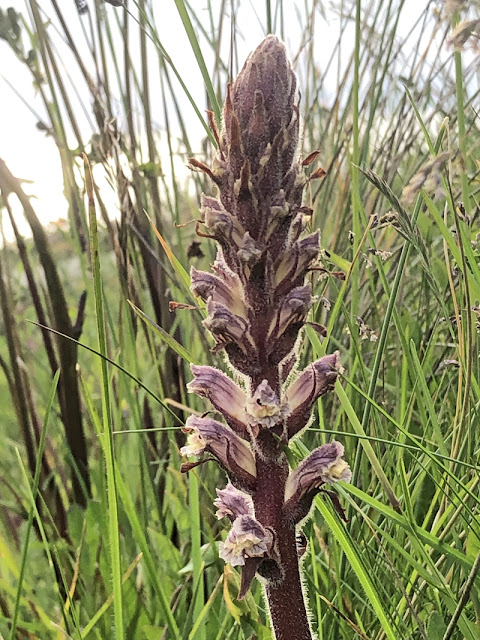This blog is a compilation of short trips out and about in Cornwall, usually just for a couple of hours in the evening. On a walk near my house I found a patch of Greater Quaking Grass growing on a roundabout of the A39. It wasn't there last year, so I wonder how it got there? It's quite a common escape here, but the seeds are big and heavy, so they tend to form large patches rather than spread much. I can only think birds have spread them, but who really knows.
Briza maxima
Nearby was Fodder Salad Burnet, which I did find last year on this road verge. It can grow up to around a metre tall and has much bigger, deeply cut leaves than the native form.
Poterium sanguisorba subsp balearicum
Common Vetch is in flower all over the place, but the vast majority have two tone pink and purple flowers. There's a patch of plants near my house which were all white, quite unusual.
Vicia sativa subspecies segetalis var. albiflora
A visit to the coastal path near Treligga was a nice walk, competely alone with nature and off the tourist areas. The vivid blue flowers of Sheep's-bit were now in flower. They are also found inland on Bodmin Moor and heathy places in Cornwall.
Jasione montana
I finally found Changing Forget-me-not in the subspecies that has yellow flowers (not white) that turn to blue. There are other differences, but it gets long and technical, so I'll leave it there. This plant was very small and the flowers tiny.
Myosotis discolor subspecies discolor
It seems cattle don't like Ivy-leaved Water Crowfoot plants. I went through such a field full of cattle, but they left these alone, so I guess they may have toxins in them. The flowers are much smaller than most other species and of course, the ivy shaped leaves are a giveaway too.
Ranunculus hederaceus
Near Treligga, I came across some boulders with very short turf around them. I was pleased to find some unusual clovers there. Trifolium striatum (Knotted Clover) had previously been recorded here, but unfortunately, I couldn't find that one.
Birdsfoot Clover - Trifolium ornithopodioides
Subterranean Clover - Trifolium subterraneum
Slender Trefoil - Trifolium micranthum
A big surprise plant was in the village of Treligga itself on a rural road verge. Below is Pyrenean Valerian, a very uncommon garden escape here. It's only been recorded in the wild in East Cornwall once before, back in 1951. Given this rarity, it will feature in the upcoming BSBI News under the "Aliens and Adventives" section, always worth a read to see what alien plants you might now find in the wild.
Valeriana pyrenaica
Below is the path from Treligga to the coast path, empty of people, just how I like it. This was the area where the unusual clovers were found and pretty much, nowhere else.
On an evening trip to Trevone to sit by the sea for half an hour, I took a wander around near the car park and found several spikes of what is now called Carrot Broomrape. It parasitises Sea Carrot (rarely Buckshorn Plantain too). I think Broomrapes are impressive plants and they do not seem to harm the host to any extent. You can see the Sea Carrot leaves at the bottom of the first photo.
Orobanche minor subspecies maritima
Actually in the beach car park and driven over most days, were patches of Toothed Medick. As the name suggests the leaflets are toothed, but what you really need to look for are the stiplules at base of the leaf junctions. They are very spikey (laciniate), unlike any other medick/clover like plant. A few weeks later I went back and noticed the very dry car park stuffed full of their little spiny seeds, waiting for a small animal or someone's sock to latch onto and be dispersed.
Medicago polymorpha
At the back of a pub car park near Wadebridge, was a gravel area and the aggregate appeared to come from the Clay Country (St Austell area). This aggregate has hardly any nutrients and nothing much grows on it for several years. One early coloniser is Birdsfoot, a tiny pea like plant that forms small clumps close to the ground.
Ornithopus perpusillus
Common Broomrape, typically parasiting Clovers (this was on Trifolium dubium and T. campestre) close to my house, a new monad record too.
Orobanche minor subspecies minor
My final offering on this blog is the wonderful, though poorly named, Bastard Balm. It's flowers are large and brightly coloured with pink or purple blotches. You can find it on shaded road verges and woodland paths in early May here. This species is completely absent from the South East where I used to live, so it was great to see it.
Melittis melissophyllum
That beautiful plant concludes my botanical adventures up until mid May, but watch out for the rest of my end of May discoveries, coming soon.
Take Care
Dave





























No comments:
Post a Comment
All comments are moderated before publication, so please don't bother spamming me, thank you. Genuine comments most welcome.